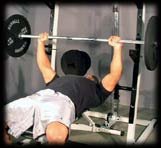
Arnold whipped Mike's butt in the competition (Mr. Olympia), both retired, and that's pretty much it.
Today, the question is still sort of lingering in mid-air. We have professional bodybuilders that advocate both schools of thought. Bodybuilders like Lee Priest and Markus Ruhl are known for doing up to 20 sets for the pecs alone. Dorian Yates, for one, believes in the "less-is-more"-principle. Interestingly enough, this time the Heavy Duty-based thinking man (Dorian) seem to score considerably better than Volume-Based bodybuilders (6 straight Mr. O victories vs. a 5th or 6th placing at best, I think).
What does this all boil down to? Obviously, just judging from contest results won't get you anywhere, so we'll have to look at it from a physiological perspective:
-
Question: What are we trying to achieve here?
-
Answer: Muscle growth.
-
Answer: By convincing the muscle that it needs to grow.
-
Answer: Expose it to stress beyond what it can comfortably handle.
This is where the two schools of thought differ. Volume-advocates reason that prolonged workouts with plenty of workload involved will sufficiently exhaust the muscles. Heavy Duty-advocates counter by the fact that the muscles need to be pushed beyond their comfort zone, and that brief workouts with extremely heavy weights is the only way to achieve it. Both principles have drawbacks!
Volume Training: Obvious risk of overtraining, which will effectively put all progress to a screeching halt. There's also the risk that you're mentally preparing for the many sets to come, and neglect to go all-out in your first sets when you're at your strongest, in order to save strength for later. This mean you'd get a so-so workout all the way through, without any real stimulation.
Heavy Duty: Overwhelming risk of injury. If you're 100% sure about your form you'll probably get away with it, but if you're going max-max-max all the time, and cheat, you're doomed to injury. It's also not very friendly to new trainers, and bodybuilders with old injuries often find that this approach causes pain in knees, backs, shoulders, and other classic "injury-spots".
The Solution Gee... What could the solution be? Well, try combining the two, so that you get the best from both worlds.
I don't believe in training for hours on end, nor do I jump of joy on the thought of tearing my shoulder again (once is perfectly enough, if you know what I mean). I have found a simple 2-sets-per-exercise routine to work the best. That means, I do one set going all-out for, say 8-10 reps, remove 10% of the weight, and do another set of 8-10 reps, again squeezing the last ounce of energy by the end of the last rep. Then I move on to the next exercise.
The total number of sets usually stays in the 4-6 zone (that's 2-3 exercises) per muscle group.
What is my reasoning behind that?
In a perfect world, you might get away with doing a single, heavy set. I don't feel like I can sufficiently kill the muscle with only 1 set. Doing a third set, on the other hand, feels like a huge waste of time - if I can't trigger a growth-response with the first 2 sets, then what would make me any more able after I've blown the initial energy away? With 2 sets, I catch what I might have missed with the first set, without robbing myself of energy for no reason in a third set.
 Last but not least, why only 2-3 exercises? I reason that with 2-3 exercises, I should be able to hit the muscle from every vital angle (except back, which requires 4-6 exercises). What would be the point of going from flat dumbbell press to flat barbell press, and then go to three machines that imitate the exact same range of motion as a bench press? And more importantly, how much energy have you robbed yourself of by the time you finally do an inclined-press for the upper pecs?
Last but not least, why only 2-3 exercises? I reason that with 2-3 exercises, I should be able to hit the muscle from every vital angle (except back, which requires 4-6 exercises). What would be the point of going from flat dumbbell press to flat barbell press, and then go to three machines that imitate the exact same range of motion as a bench press? And more importantly, how much energy have you robbed yourself of by the time you finally do an inclined-press for the upper pecs?
Keep in mind though, that we are all different. Experiment. If you get better results in one way of the other - by all means, stick with that! Just make sure to keep it safe, fun, and productive!
PS: Perhaps it's worth noticing that both Arnold and Dorian have proven themselves to be men of incredible willpower and confidence. That's not to say that the opponents were losers, more like that even though a normal car can be in perfect condition, it'll still look dwarfed next to a huge SUV.
As for winning, let's not forget that the BIG difference between the winner and the loser is always in the heads.
Thanks,
